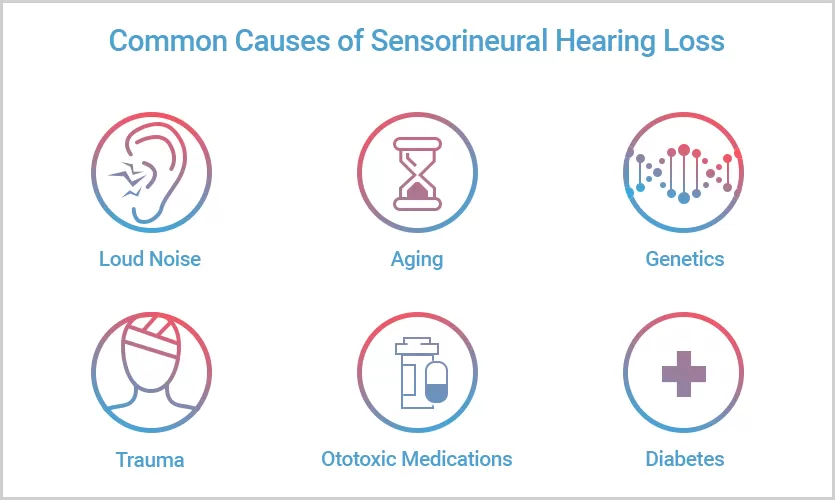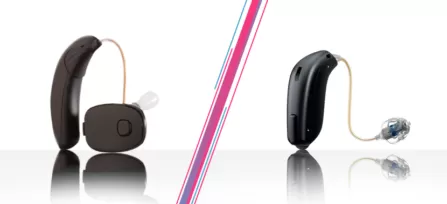Sensorineural Hearing Loss
Causes, symptoms, treatment options
It is estimated that 15% of American adults (37.5 million) report some trouble hearing.
Of these 37.5 million individuals, over 90% have what is called sensorineural hearing loss.
This makes sensorineural hearing loss the most prevalent type of hearing loss, by a long shot.
Sensorineural hearing loss has unique causes, symptoms, and treatment options, and in this post we’ll explore those topics and more.
What is sensorineural hearing loss?
The answer is in the name.
Sensorineural is a two-part word:
Sensory, referring to the cochlea in your ear, and
Neural, referring to the auditory nerve.
A sensorineural hearing loss is a hearing loss due to damage to one of these two parts- either the inner ear (cochlea), or the nerve that sends sound from your ear to the brain (auditory nerve).
In order for any of that to make sense, it’s important to first understand how hearing works, and the roles of the cochlea and auditory nerve.
How hearing works

- The outer ear collects sound from around you - like a funnel - and directs it into your ear canal.
- Sound travels down your ear canal until it hits your eardrum and makes the eardrum vibrate.
- As a result of the eardrum vibration, the ossicles (little bones) vibrate.
- The ossicle vibration then causes the fluid inside the cochlea to vibrate.
- The fluid vibration inside of the cochlea activates hair cells that send signals to the brain via the auditory nerve.
The key to sensorineural hearing loss lies in step 5, with those those hair cells in the cochlea.
When the ear bones (ossicles) vibrate the fluid in the cochlea, it’s like dropping a rock at one end of a pond.
Waves travel up and down the fluid in the cochlea, like the waves would spread in the water in the pond when you drop a rock at one end.
In the cochlea’s fluid, there are structures called hair cells.
The hair cells are not, despite the name, actually strands of hair. They are just called that because part of the cell structure is long and thin and bends when waves travel through the fluid.
The hair cells move when the fluid vibrates, and the hair cell movement sends signals to your brain via the auditory nerve.
Check out the cool picture of hair cells in the cochlea, below.
They have those white strands that you see sticking up. These strands will bend when waves travel through the fluid.

Your auditory nerve fires in different patterns depending on how your hair cells in the cochlea are moving.
Your brain interprets the signals that it gets from the auditory nerve.
As a result of your brain’s interpretation of one pattern, you become annoyed that the neighbor’s dog is barking, yet again.
More pleasantly, another pattern from your auditory nerve gets interpreted by your brain as your partner saying “I love you”.
So, that is how your hearing is supposed to work.
When hearing problems arise, it’s usually the result of a breakdown somewhere in that process.
And when hearing problems do arise, one of the first things you’ll want to determine is the type of hearing loss you have.
Why?
If you don’t know the type of hearing loss you have, you don’t know the best way to treat it.
For example-
In the image above, the primary purpose of steps 1-4 was essentially to “move” the sound from the outer ear, through the middle ear to the inner ear.
So early on in the hearing process (steps 1-4), that sound is “conducted”- ie, it’s passed along from the external environment, to the inner ear.
If there is a problem conducting that sound, maybe with the eardrum, or middle ear bones, that means there is a conductive hearing loss.
Unlike sensorineural hearing loss, conductive hearing loss often can be corrected by medications or surgery, so it would be foolish to treat them the same way.
Once you know whether you have a sensorineural or conductive hearing loss, you can begin to evaluate appropriate treatment options.
How do you know if you have sensorineural hearing loss?
You may have a sensorineural hearing loss if you experience any of these symptoms, but the only way to know for sure is to get a hearing test.
The main purpose of the hearing test, aside from measuring your overall hearing ability, is to determine the type of hearing loss you have.
In order to do that, your hearing care provider is going to administer a few tests, which essentially aim to determine (or make an educated guess) as to where in the 5 step process the problem is occurring.
Your hearing care provider will want to find out if the problem exists somewhere in the ear canal or middle ear, in conducting the sound to your inner ear, or if the problem exists in the cochlea or auditory nerve, sending that signal to your brain.
The way we isolate where the breakdown is occurring, is by performing two types of hearing tests: air conduction testing and bone conduction testing.
Air conduction testing is the test where your hearing care professional places a set of headphones over or in your ears. You have to raise your hand or press a button when you hear a beep. The beeps have to travel through your entire ear - down your ear canal, through the eardrum and the ossicles, and through the cochlea and the nerve - for you to hear them. When most people think of getting a hearing test, this is what they think of, and it’s the kind that almost all of us are given periodically in elementary school.
Bone conduction testing is the test where your hearing care professional places a metal headband on your head, with a black vibrator that fits behind one of your ears. You have to raise your hand or press a button when you hear a beep. The vibrator sends sound into your cochlea by vibrating the bone behind your ears. This sound travels directly into the cochlea, bypassing the ear canal and eardrum.
If you’re following along, you can probably see why bone conduction testing is necessary, and what it tells us.
To recap, air conduction testing measures your hearing the traditional way- it sends sound through your ear canal and measures your natural ability to hear that way.
Bone conduction bypasses that natural process, and sends sound directly to the cochlea.
So, if your test results show that you heard better via bone conduction than air conduction, what do you think that means?
Usually, it means there is something in the ear canal or middle ear which is preventing the transmission of sound before it gets to the cochlea, or in other words, the sound is somehow being “dampened” when it travels the usual route.
So when your hearing care provider looks at your test results, one of the primary things they are looking at is if there is a difference in how you hear with these two kinds of testing.
If you hear better by bone conduction, part of your hearing loss results from blockage of sounds from getting into your ear and traveling to the cochlea. You have a conductive hearing loss.
In other words, sounds have to be louder for you to hear them when we send the sounds down the normal pathway through your ear canal and eardrum.
If there is no difference between air conduction and bone conduction, your hearing loss is probably sensorineural.
In a sensorineural hearing loss, sounds are able to reach the cochlea without a problem, but you have damage to the cochlea or auditory nerve.
Causes of sensorineural hearing loss

Most of the time, sensorineural hearing loss results from aging.
The wear and tear on your hair cells in your cochlea causes you to gradually lose some of the hearing sensitivity that you had when you were younger, and it’s the high frequencies that go first.
A hearing care professional may not be able to tell you the exact cause of your sensorineural hearing loss.
Some clues to the likely contributors to your hearing loss may come from your answers to questions like:
- What kinds of hobbies and jobs have you had?
- When did you start to notice your hearing problem?
- What kinds of medications do you take?
- What other medical problems do you have?
You have a higher risk of sensorineural hearing loss if you:
- Have diabetes and cardiovascular disease: Diseases that affect how well blood gets to the cells of your ear can, over time, lead to damage to hair calls.
- Smoke: Smoking not only increases your risk of hearing loss, it also affects the hearing of other people who are exposed to your smoke.
- Work at a noisy job or spend time doing noisy hobbies: Factory work, construction, military service, hunting, and music performance are all activities that can damage your hearing over time.
Some medications can damage your hearing and cause sensorineural hearing loss. The major ones are chemotherapy drugs (platinum-based, drug names end in -platin) and aminoglycoside antibiotics (drug names usually end in -mycin or -micin).
More rarely, you can have sensorineural hearing loss from birth or early childhood as a result of inner ear malformations, prematurity, or infections.
There are three more serious causes of sensorineural hearing loss.
If you have one of these problems, your hearing care professional should refer you to a doctor:
- Meniere’s disease: This is a disease where there is too much fluid in the cochlea. You may have fluctuating hearing loss, tinnitus, and dizziness:
- Tumors on the auditory nerve: If you have hearing that is worse in one ear than the other, your hearing care professional may refer you to a doctor to rule out a tumor on the nerve.
- Sudden sensorineural hearing loss: If you suddenly lose your hearing, you need to be seen by an ENT as soon as possible. The ENT may give you steroids, which are most effective when given soon after a sudden hearing loss.
Symptoms of sensorineural hearing loss

Most of the time, sensorineural hearing loss happens gradually.
Because of this, you may not notice that you’re not hearing as well as before.
However, your family members and friends may complain that they have to repeat themselves, or that you have the television turned up too loud.
If you have sensorineural hearing loss, you may have these complaints:
- People sound like they mumble, because you cannot hear as clearly.
- You have a hard time hearing in noisy places like restaurants.
- You struggle to understand people on the phone.
- You spend less time in social activities because it’s too difficult.
- You get tired more easily because of the effort that it takes you to listen.
- You have increased depression and anxiety.
Some people with sensorineural hearing loss have problems tolerating loud sounds. This is called hyperacusis.
Because the ears also play a role in balance, some people with sensorineural hearing loss also experience dizziness or imbalance.
Treatment options
You usually cannot cure sensorineural hearing loss with medications or surgery, so your best option will often be to consider hearing aids.
What if you’re not yet ready to wear hearing aids?
There are steps you can take to improve your quality of life, even without buying hearing aids.
- Buy TV Ears to make it easier to hear the television
- Turn on captioning on your television
- Request captioning or hearing assistance devices at the movies
- Put an amplifier on your telephone and/or use a captioned telephone
- Attend hearing loss support groups
- Learn strategies on how to communicate better
Of course, you always have the option to do nothing, if you feel that your hearing loss does not currently affect you.
If you’re not sure, you can take a survey such as the Hearing Handicap Inventory and discuss the results with your hearing care professional.
Conclusion
Sensorineural hearing loss is the most common type of hearing loss, and is usually caused by the general aging process or a lifetime of exposure to loud noises.
If you’re concerned that you have sensorineural hearing loss, we recommend contacting your doctor or a hearing care provider and requesting a screening.
It is important to begin using hearing aids as soon as they are recommended, as studies show that hearing loss may contribute to a faster rate of atrophy in the brain.
If hearing aids sound like something you’re just not ready for, take comfort in knowing that many people who buy hearing aids report that they wish they would’ve done it sooner.
Modern hearing aids can be completely invisible, Bluetooth compatible, rechargeable, and so comfortable you don’t even know you’re wearing them.






